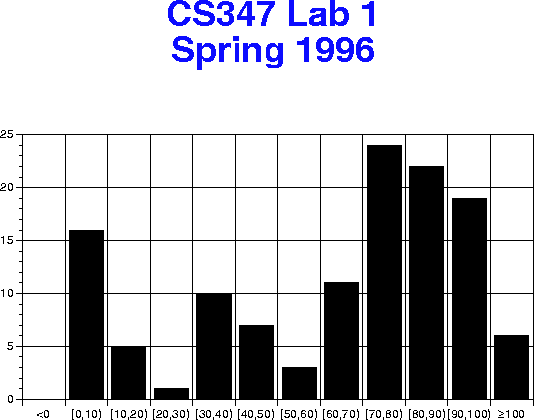#nops time 0 10 (Mips anomaly discussed in the newsgroup) 1 9 2 10 (here is where linearity starts) 3 11 4 12
Problem 2
This should have been fairly straightforward. The biggest problem was that measurements were gathered without accumulating enough timer periods. Some students confidently reported numbers that didn't make any sense, such as "each nonzero requires 0.01 clock cycles".Problem 3
Most students did well on this problem. The basic idea was to perform the crossover analysis using some kind of binary search. The crossover point between sparse and dense representations was typically around 70%.Problems 4 and 5
Problems 4 and 5 were the core of the assignment. Students had a great deal of trouble with these problems and many didn't make the connections we hoped you would make. There are some basic principles that govern these kinds of optimization problems:- The first key idea is to optimize the common case. Focus first on the inner loop, then focus on the outer loop.
- Another key idea is to eliminate memory references to operands that could just as easily be stored in registers. Changing a memory reference to a register reference is called promoting a variable to a register. Even very good optimizing compilers have trouble promoting variables to registers if they are an array element or if they referenced by a pointer. However, scalars are easily promoted to registers.
- Pointer code can help to eliminate the incrementing of index variables, and shifts that convert word offsets to byte offsets. In general, though, gains will be small.
| (a) Original C code | (b) Promoting z[r] to a register | (c) Eliminating an index update | |
|---|---|---|---|
int r, ci;
for (r = 0; r < M->nrow; r++) {
z[r] = 0.0;
for (ci = M->rstart[r];
ci < M->rstart[r+1];
ci++) {
z[r] += M->val[ci] *
x[M->cindex[ci]];
}
}
|
for (r = 0; r < M->nrow; r++) {
ftype_t temp = 0.0;
for (ci = M->rstart[r];
ci < M->rstart[r+1];
ci++) {
temp += M->val[ci] *
x[M->cindex[ci]];
}
z[r] = temp;
}
|
int r;
ftype_t *val = M->val;
int *cindex_start = M->cindex;
int *cindex = M->cindex;
int *rnstart = M->rstart+1;
for (r = 0; r < M->nrow; r++) {
ftype_t temp = 0.0;
int *cindex_end =
cindex_start + *(rnstart++);
while (cindex < cindex_end) {
temp += *(val++) *
x[*cindex++];
}
z[r] = temp;
}
| |
0x4c: lw v1,16(t0) 0x50: sll v0,a3,2 0x54: addu v0,v0,v1 0x58: lw v1,12(t0) 0x5c: lw v0,0(v0) 0x60: addu a0,a0,v1 0x64: sll v0,v0,3 0x68: addu v0,v0,a1 0x6c: lwc1 $f2,0(a0) 0x70: lwc1 $f3,4(a0) 0x74: lwc1 $f0,0(v0) 0x78: lwc1 $f1,4(v0) 0x7c: nop 0x80: mul.d $f2,$f2,$f0 0x84: lwc1 $f0,0(t1) 0x88: lwc1 $f1,4(t1) 0x8c: nop 0x90: add.d $f0,$f0,$f2 0x94: swc1 $f0,0(t1) 0x98: swc1 $f1,4(t1) 0x9c: lw v0,20(t0) 0xa0: nop 0xa4: addu v0,t2,v0 0xa8: lw v0,4(v0) 0xac: addiu a3,a3,1 0xb0: slt v0,a3,v0 0xb4: bne v0,zero,0x4c 0xb8: sll a0,a3,3 |
0x5c: lw v0,0(v1) 0x60: lwc1 $f2,0(t0) 0x64: lwc1 $f3,4(t0) 0x68: sll v0,v0,3 0x6c: addu v0,v0,a1 0x70: lwc1 $f0,0(v0) 0x74: lwc1 $f1,4(v0) 0x78: nop 0x7c: mul.d $f2,$f2,$f0 0x80: addiu t0,t0,8 0x84: addiu v1,v1,4 0x88: addiu a3,a3,1 0x8c: slt v0,a3,t2 0x90: bne v0,zero,0x5c 0x94: add.d $f4,$f4,$f2 |
0x48: lw v0,0(v1) 0x4c: lwc1 $f2,0(t0) 0x50: lwc1 $f3,4(t0) 0x54: sll v0,v0,3 0x58: addu v0,v0,a1 0x5c: lwc1 $f0,0(v0) 0x60: lwc1 $f1,4(v0) 0x64: nop 0x68: mul.d $f2,$f2,$f0 0x6c: addiu v1,v1,4 0x70: addiu t0,t0,8 0x74: sltu v0,v1,a3 0x78: bne v0,zero,0x48 0x7c: add.d $f4,$f4,$f2 |
Figure 1: Optimizing C code
Statistics
Figure 2 shows the histogram of scores for Lab 1. The mean score was 69. The median score was 75. There were 6 perfect scores.
|
Figure 2: Lab 1 grades